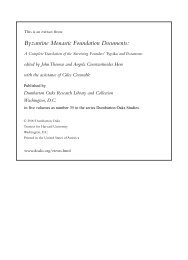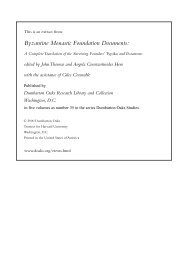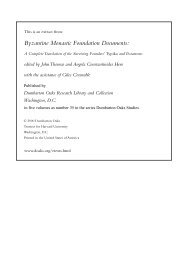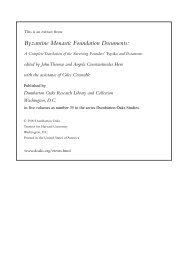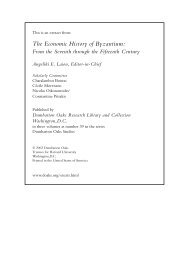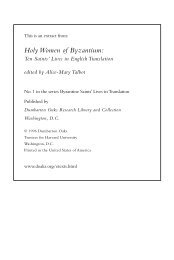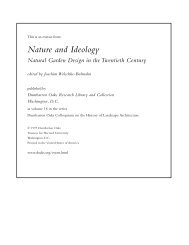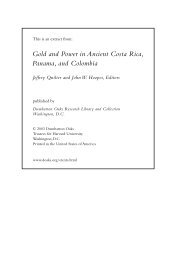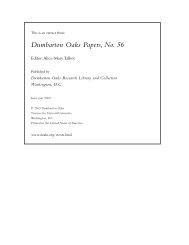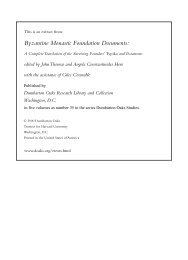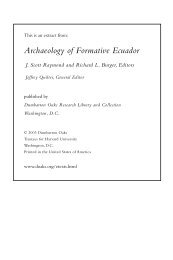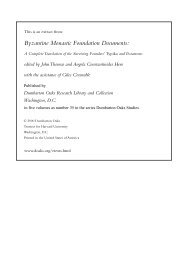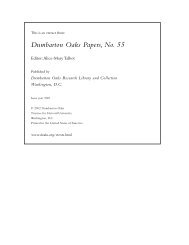Changing Economic Patterns in Latin Romania - Dumbarton Oaks
Changing Economic Patterns in Latin Romania - Dumbarton Oaks
Changing Economic Patterns in Latin Romania - Dumbarton Oaks
Create successful ePaper yourself
Turn your PDF publications into a flip-book with our unique Google optimized e-Paper software.
David Jacoby [225]<br />
panies, significantly contributed to economic growth <strong>in</strong> the non-Venetian territories<br />
of Lat<strong>in</strong> <strong>Romania</strong>. Credit operations and transfers of money were partly achieved by<br />
<strong>in</strong>vestment <strong>in</strong> maritime trade. Sienese merchants conveyed wax from <strong>Romania</strong> to the<br />
fairs of Champagne, as attested <strong>in</strong> 1265 by Andrea Tolomei, member of an important<br />
company based <strong>in</strong> Siena, <strong>in</strong> a letter sent from Troyes. 166 An unidentified Sienese company<br />
apparently exported silk from Chiarenza <strong>in</strong> the 1270s, and kermes from <strong>Romania</strong><br />
reached Siena, as attested by a Sienese custom list compiled between 1273 and 1313. 167<br />
Cont<strong>in</strong>ental Greece, especially the Peloponnesos, as well as some islands of the Aegean<br />
and the Ionian Sea, were major exporters of this expensive dyestuff used <strong>in</strong> textile manufacture.<br />
168 The Florent<strong>in</strong>e mercantile bank<strong>in</strong>g house of the Alberti shipped kermes from<br />
Cor<strong>in</strong>th and Monemvasia, as well as from the islands of Cerigo and Cephalonia. 169 By<br />
the late thirteenth century, some Italian mercantile and bank<strong>in</strong>g companies had extended<br />
their operations to Cor<strong>in</strong>th, a thriv<strong>in</strong>g and affluent economic center until the Catalan<br />
attack of 1312. 170 Their large-scale f<strong>in</strong>anc<strong>in</strong>g of warfare and of conspicuous consumption<br />
brought large <strong>in</strong>fusions of liquid capital.<br />
These activities, comb<strong>in</strong>ed with the <strong>in</strong>troduction of advanced bus<strong>in</strong>ess methods <strong>in</strong>to<br />
Lat<strong>in</strong> Greece from the second half of the thirteenth century, such as deposit accounts<br />
with payment on demand, transfer bank<strong>in</strong>g, double-entry bookkeep<strong>in</strong>g and management,<br />
contributed to an <strong>in</strong>tensification of trade and an acceleration of the monetary<br />
flow. 171 The bank<strong>in</strong>g practices <strong>in</strong>troduced <strong>in</strong>to the Frankish territories also spread to<br />
Venetian Coron and Modon, the economy of which was tightly l<strong>in</strong>ked to theirs. 172 I<br />
have already noted the <strong>in</strong>tegration of Italians with<strong>in</strong> the knightly class of Frankish Morea<br />
beg<strong>in</strong>n<strong>in</strong>g <strong>in</strong> the second half of the thirteenth century, among them merchants and bankers.<br />
In the follow<strong>in</strong>g century we f<strong>in</strong>d Italian <strong>in</strong>tendants adm<strong>in</strong>ister<strong>in</strong>g large feudal estates,<br />
several of which belonged to absentee Italian landlords. Italian lords and <strong>in</strong>tendants were<br />
familiar with sophisticated bus<strong>in</strong>ess techniques and had a clear impact on the exploitation<br />
of Moreot estates. They <strong>in</strong>troduced structural changes <strong>in</strong> their management, a more<br />
rational organization of space and use of resources, whether land, water, beasts of labor<br />
166 C. Paoli and E. Piccolom<strong>in</strong>i, eds., Lettere volgari del secolo XIII scritte da Senesi (Bologna, 1871), 57.<br />
167 See Jacoby, “Migration,” 112–13; M. A. Ceppari and P. Turr<strong>in</strong>i, eds., “Documenti: Il commercio delle<br />
stoffe; l’abbigliamento e le provvisioni di lusso; arredi sacri e profani,” <strong>in</strong> “Drappi, velluti, taffetà et altre cose.”<br />
Antichi tessuti a Siena e nel suo territorio, ed. M. Ciatti (Siena, 1994), 245.<br />
168 See Jacoby, “Silk Production,” 45–47, 61.<br />
169 A. Sapori, I libri degli Alberti del Giudice (Milan, 1952), 71, 101, and 229.<br />
170 See Jacoby, “Migration,” 103–4, 114. The assessment of destruction <strong>in</strong>flicted by the Catalans has recently<br />
been somewhat tempered by the suggestion that major destruction may have been caused by an earthquake that<br />
occurred ca. 1300: see C. K. Williams II, E. Barnes, and L. M. Snyder, “Frankish Cor<strong>in</strong>th: 1996,” Hesp 66<br />
(1997): 41–42.<br />
171 See Jacoby, “Migration,” 113, 121–27. Accounts are mentioned by Mar<strong>in</strong>o Sanudo Torsello <strong>in</strong> Hopf,<br />
Chroniques, 101–2: “Nel suo tempo fù nel pr<strong>in</strong>cipato tanta cortesia e amorevolezza, che non solamente li cavallieri<br />
mà anche li mercadanti andavano sù e giuso senza denari ...econilsemplice loro scritto di mano se li<br />
dava denari.” S<strong>in</strong>ce Sanudo refers to the reign of Pr<strong>in</strong>ce William II, who ruled from 1248 to 1278, the <strong>in</strong>troduction<br />
of deposit accounts <strong>in</strong>to Greece should be placed <strong>in</strong> the latter’s reign, thus earlier than <strong>in</strong> Venice, on which<br />
see R. C. Mueller, The Venetian Money Market: Banks, Panics and the Public Debt, 1200–1500 (Baltimore, 1997),<br />
9–18, esp. 15–16.<br />
172 See below, pp. 227–28, 231.




